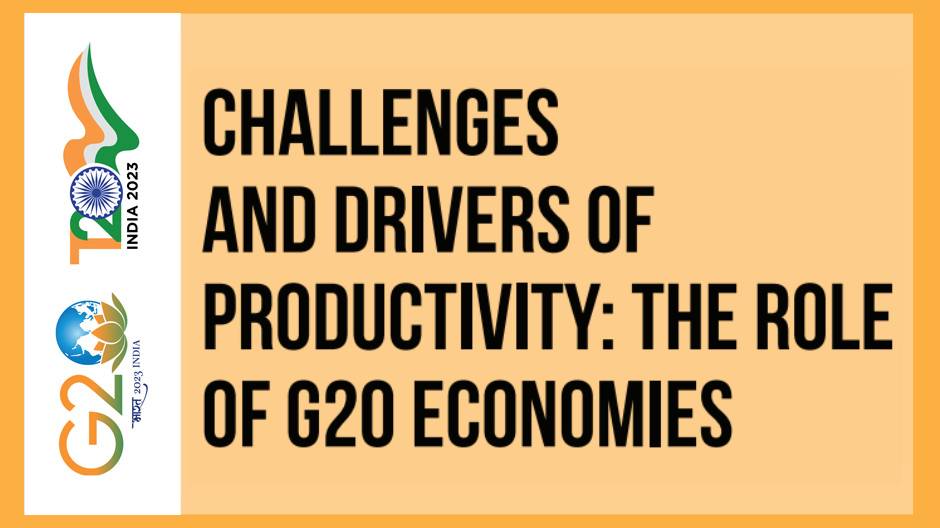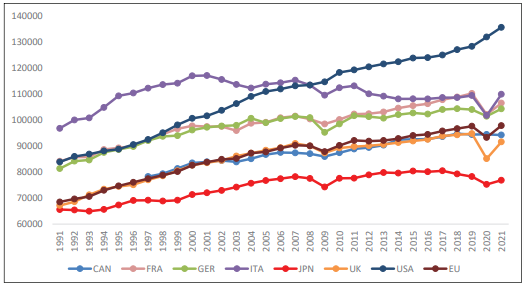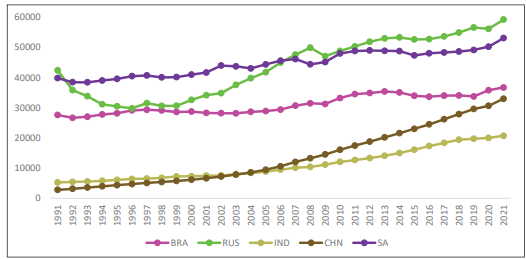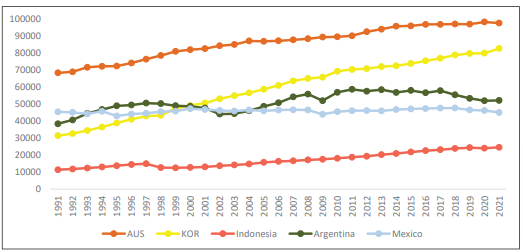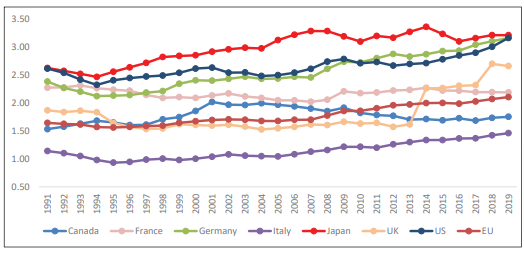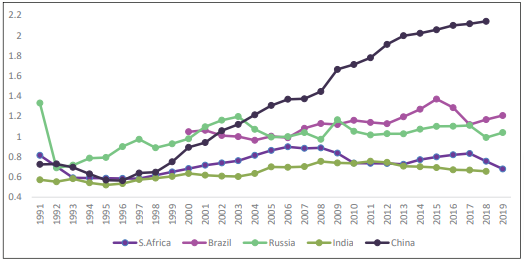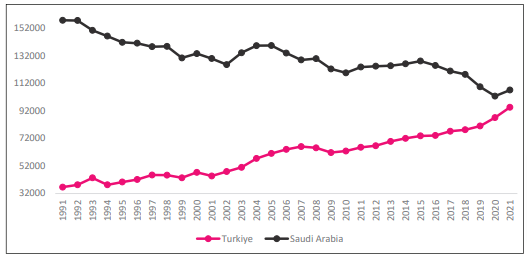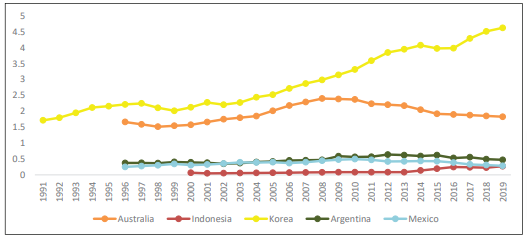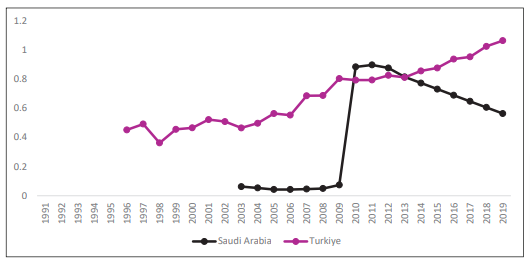Abstract
While physical inputs are an important factor contributing to economic growth, and thus, the overall welfare of the global economy, productivity growth is important to sustain economic growth in the long-run. The COVID-19 pandemic led to setbacks in both productivity and economic growth across the world, thereby making it imperative to revisit the factors that determine long-term productivity. This Policy Brief (i) examines the trends in labour productivity of the G20 economies from 1991 to 2021; (ii) explains the factors that could influence productivity in the long-run based on recent empirical literature; and (iii) makes suggestions to policymakers of the G20 on ways to increase and sustain productivity growth.
The Challenge
“Productivity is not everything though in the long run it is almost everything. A country’s ability to raise its standard of living depends almost entirely on its ability to raise its output per worker.” Paul Krugman (1994).
Improvements in productivity help determine how fast an economy can grow and how fast the average standard of living of that economy grows. Fischer (2017) argues that growth in productivity determines the rate of growth of average per capita income in the long-run. It is therefore important to increase and maintain the level and rate of growth of productivity in an economy. Since economies of the world are interdependent due to trade of goods and services and flows of capital across them, it is important to determine what could increase productivity across countries.
The recent trends in labour productivity of the G20 member nations from 1991 to 2021, therefore, need to be discussed.[1] Labour productivity is defined as output per unit of labour input. Labour productivity of an economy is measured in this Policy Brief by the ratio of GDP—measured in 2017 purchasing power parity (PPP) in US$—to total persons employed in an economy. The data on labour productivity is drawn from World Development Indicators (WDI), October 2022.
The G20 comprises 20 member nations across the world with Canada, France, Germany, Italy, Japan, the UK, the US, the European Union (EU), Australia, and the Republic of Korea or South Korea as the advanced countries; and Brazil, Russia, India, China, South Africa, Indonesia, Argentina, Mexico, Turkiye, and Saudi Arabia as the emerging and developing countries. These countries could be classified into various sub-groups: advanced economies of G7—that is, Canada, France, Germany, Italy, Japan, the UK; the EU; the Asia–Pacific economies of Australia, Indonesia, and South Korea; Latin American economies of Argentina and Mexico; the Middle-East economies of Turkiye and Saudi Arabia; and the BRICS (Brazil, Russia, India, China, and South Africa) economies.
The trends in labour productivity of these sub-groups from 1991 to 2021 are discussed in Figures 1 to 4.
The trends in labour productivity of the major advanced economies of G7 along with the EU, as shown in Figure 1, indicate that all countries (except Japan) recorded an upward trend from 1991 to 2021. However, these countries (except the US) experienced falls in productivity during the global financial crisis of 2007–09 and that of COVID-19 from 2019 to 2020.
Figure 1: Trends in Labour Productivity (GDP per worker in constant 2017 PPP $US) of G7 and EU Economies, 1991–2021
Source: Authors’ computation from WDI (2022).
As for the BRICS economies, while Brazil and South Africa show moderate growth in productivity, India and China experienced phenomenal growth from 1991 to 2021 (Figure 2). Indeed, China recorded exponential growth during this period.
Figure 2: Trends in Labour Productivity (GDP per worker in constant 2017 PPP $US) in BRICS Economies, 1991–2021
Source: Authors’ compilation from WDI (2022).
Further, Russia showed a decline in the level of labour productivity in the beginning of the period, and an upward trend post-1997 (except for a fall during the global financial crisis of 2007–09).
The trends for the Asia–Pacific economies (including Australia, Indonesia, and South Korea) and Latin America (Argentina and Mexico) are shown in Figure 3. While Mexico had constant labour productivity throughout the period from 1991 to 2021, Argentina showed moderate growth with volatility.
Figure 3: Trends in Labour Productivity (GDP per worker in constant 2017 PPP $US) of Asia–Pacific and Latin American Economies, 1991–2021
Source: Authors’ compilation from WDI (2022).
The trends of the three Asia–Pacific economies show a consistent rise (Figure 3). Though South Korea started at a very low level of productivity (same as that of Mexico and Argentina), it showed a consistently upward trend that could catch up with Australia. Indonesia had a setback in 1997 owing to the Asian financial crisis, but it continued to show an upward trend throughout the period under study.
Finally, the trends in the Middle-East countries of Turkiye and Saudi Arabia indicate that while Turkiye recorded a three-fold rise in labour productivity, Saudi Arabia experienced a downward trend. The opposite trends in the two countries have led to their convergence (Figure 4).
Figure 4: Trends in Labour Productivity (GDP per worker in constant 2017 PPP $US) of Middle-East Economies, 1991–2021
Source: Authors’ compilation from WDI (2022).
It may be concluded that there has been a mixed experience for the member nations of the G20 on aggregate labour productivity from 1991 to 2021. While countries like the EU, France, Germany, Russia, South Africa, Argentina, and Turkiye have shown moderate but consistent rise in labour productivity throughout the period, Brazil, Saudi Arabia, Italy, Japan, and Mexico have shown downward trends, and therefore need immediate attention.
The Asia–Pacific economies of India, China, Australia, Korea, and Indonesia have shown signs of catching up with the advanced economies. Indeed, these five economies together account for 30.9 percent (slightly more than that of G7 nations) of world GDP in PPP terms as of 2022 (WEO, IMF, 2023). A number of economies, including South Korea, Indonesia, and Australia were adversely hit by the COVID-19 pandemic and experienced a slowdown in the productivity growth rate. Moreover, the COVID-19 pandemic has raised challenges about the sustainability of high levels of productivity in these economies.
Table 1 depicts the decadal averages of labour productivity[2] of the three key economic sectors—agriculture, industry, and services—of the G20 countries. Table 1 suggests that industry and services are on average more productive than agriculture.[3] However, the average productivity of each sector has been growing over time. Argentina has been an exception: It has shown a much higher productivity of the agriculture sector when compared with that of the industry and services sectors in all the three decades.
| Table 1: Decadal Averages of Labour Productivity (GDP 2015 $US per worker) of Major Economic Sectors of G20 Countries | |||||||||
| Decade | 1991-2000 | 2001-10 | 2011-19 | ||||||
| Country group\Sector | Agri | Ind | Ser | Agri | Ind | Ser | Agri | Ind | Ser |
| G7 plus EU | 26654.7 | 65418.0 | 72568.6 | 42328.6 | 76086.6 | 77399.6 | 50578.9 | 83491.0 | 79346.6 |
| BRICS | 2719.3 | 11438.2 | 10542.9 | 4160.7 | 13922.2 | 12285.3 | 6502.0 | 17113.5 | 15085.3 |
| Asia–Pacific | |||||||||
| Australia | 48462.6 | N.A. | N.A. | 72358.8 | N.A. | N.A. | 95240.0 | 139394.5 | 98656.7 |
| Korea | 9070.0 | N.A. | 28962.7 | 13482.0 | N.A. | 37227.8 | 18899.1 | 74123.7 | 43946.1 |
| Indonesia | 1587.1 | 11047.4 | 4524.7 | 1952.9 | 12620.0 | 5135.8 | 2861.5 | 13278.6 | 6647.5 |
| Latin America | |||||||||
| Argentina | 260081.4 | 27026.1 | 20487.8 | 139719.2 | 31901.5 | 20658.8 | 995407.4 | 32304.2 | 23659.7 |
| Mexico | 3972.9 | 30351.7 | 22338.3 | 5021.9 | 28990.3 | 21706.1 | 5431.3 | 27077.5 | 22450.1 |
| Middle-East | |||||||||
| Turkiye | 6757.5 | 14922.0 | 23288.1 | 8574.5 | 24081.8 | 28572.2 | 10232.3 | 32459.0 | 32161.5 |
| Saudi Arabia | 29895.0 | 150940.0 | 33228.6 | 39029.4 | 139444.9 | 33128.2 | 36434.0 | 104738.8 | 37651.5 |
Source: Authors’ compilation from WDI (2022).
This could be attributed to the exclusive policies and steps undertaken by the government of Argentina to promote the agriculture sector, such as more innovative technologies of production, and market-oriented policies.[4]
There are three issues that need to be addressed.
- How to increase the level and growth rate of aggregate productivity of economies that experienced slow growth even in the pre-COVID-19 period.
- How to sustain the high levels of aggregate productivity of economies like India, China, the US, South Korea, and Australia.
- How to raise the productivity of each of the broad sectors in the economy, especially agriculture sector, as the agriculture sector has very low productivity in the emerging and developing economies.
It is imperative to identify the potential determinants of labour productivity pertaining to both the emerging, developing economies and the developed economies and work on them so that productivity could be sustained.
Labour productivity could be influenced by a variety of factors, including capital stock per worker, human capital (which includes skills and health of labour), technological progress, structural factors, institutional quality, financial development, and macroeconomic factors (Dua and Garg, 2019, 689–91). While capital deepening, human capital, technological progress, financial development, institutional quality, structural change, and policy variables could be classified as domestic factors; trade openness, financial openness, and climate change could be termed as global factors.
While Dua and Garg (2019, 2020) have examined the determinants of aggregate labour productivity and sectoral labour productivity, respectively, for the Asia–Pacific economies from 1980 to 2014, Dua and Garg (2023, Mimeo) analysed the determinants of aggregate and disaggregated labour productivity of G7 and BRICS economies from 1980 to 2018.
Using panel cointegration and Group-Mean FMOLS, the study found that four factors—capital deepening, human capital, technological progress, and openness—influence productivity of BRICS economies positively and significantly while government size and share of agriculture in GDP influence it negatively and significantly. These four factors also influence aggregate labour productivity of the G7 economies positively and significantly while government size affects it negatively and significantly.
Thus, more capital deepening (capital stock per worker) and more human capital may enhance productivity in the long-run for both emerging and developing nations as well as the developed nations of the G20. Further, greater technological progress or constant innovations, as measured by research and development (R&D) expenditure as a ratio of GDP, is expected to bring in more productivity in both the developing and developed economies of the G20. The results further indicate that greater openness of the economies to the rest of world may increase productivity, as it brings in not only advanced technology through imports, but it also makes the exporting firms more competitive and more productive.
Moreover, the results indicate that an increased role of government may discourage productivity as it could compete with the private sector for the resources. As a result, a more efficient government that complements rather than competes with the private sector is required.
Finally, the results indicate that a shift of resources from agriculture to industry and services (as measured by the share of agriculture in GDP) enhances productivity for the BRICS economies significantly, though not for the G7 economies (Dua and Garg, 2023,172). The 2023 study of Dua and Garg further found that increase in the productivity of the manufacturing sector may lead to enhanced productivity of services sector, and vice-versa. Thus, there are significant cross-spillover effects across sectors for both G7 and BRICS economies (Dua and Garg, 2020, 698–99; 2023, 177).
Thus, capital deepening, human capital, technological progress, openness, institutional quality, policy, structural shift, and cross-spillover effects are significant determinants of labour productivity for the G20 economies over the long-run.
As discussed above, technological progress (as measured by R&D expenditure as ratio of GDP) is a positive and significant factor affecting productivity of G20 economies. The US, Japan, Germany, France, the UK, the EU, China, and South Korea have shown phenomenal progress in R&D intensity (R&D expenditure as a ratio of GDP) from 1991 to 2019; however, other countries—India, Saudi Arabia, Brazil, South Africa, Argentina, and Mexico, have a long way to go on this parameter (Figures 5 to 8).
Figure 5: R&D Expenditure as a Ratio of GDP (in %), 1991–2019 for G7 Plus EU
Source: Authors’ computations from Main Science and Technology Indicators (MSTI) database.
Figure 6: R&D Expenditure as a Ratio of GDP (%), 1991–2019 for BRICS
Source: Authors’ computations from Main Science and Technology Indicators (MSTI) database and Department of Science and Technology for India and WDI (2022) for Brazil
Figure 7: R&D Expenditure as a Ratio of GDP (in %): Latin America and Asia–Pacific
Source: Authors’ computations from Main Science and Technology Indicators (MSTI) database and WDI (2022).
Figure 8: R&D Expenditure as a Ratio of GDP (in %): Middle East
Source: Authors’ computations from WDI (2022).
The G20’s Role
High levels of productivity and its growth are required to increase and sustain the growth of an economy. Thus, increase in productivity is important to achieve certain sustainable development goals (SDGs) of Agenda 2030 like decent work and economic growth; zero hunger; and industry, innovation and infrastructure. The G20 economies may help achieve this by targeting more capital accumulation, more innovation, and by ensuring better health and education for their people.
Indeed, the US is second while China is 11th in the global innovation index (GII) ranking released by World Intellectual Property Organization (WIPO) in 2022. India is 40th in GII rankings and tops the middle-income economies, while Turkiye is placed at 37 for the first time. For countries, these are clear indicators of progress towards higher productivity and growth and must be encouraged and sustained.
It is being argued that climate change and excessive heat are affecting the productivity of labour adversely, and therefore, pose a challenge to the sustainability of productivity even in developed economies. Here, the G20 nations may help sustain productivity levels by demonstrating the use of greener and eco-friendly technologies to others economies. The steps taken by the Indian government to produce ethanol-based fuel is welcome and needs further boost.
The hike in the fair remunerative price (FRP) of sugarcane introduced in India and similar steps by Argentina to enhance the productivity of the agriculture sector should motivate other developing nations to promote their agriculture sector. Further, G20 economies may help poorer nations develop more sustainable ways of achieving higher productivity and growth through triangular cooperation.[6]
Recommendations to the G20
Having identified the factors that could influence productivity in the long-run in the G20 economies, the following policy priorities for the G20 economies are recommended so as to sustain productivity in individual economies as well as globally.
Recommendations for the emerging, developing, and developed economies
Domestic Factors
- Capital deepening. All the countries, especially developing and emerging economies must encourage more capital per worker so that the productivity of labour could increase.
- Human capital. Education and health must be promoted in the developing and developed members of the G20. The human capital project launched by the World Bank in 2020 is a welcome step. Under the project, the Human Capital Index (HCI) was introduced that benchmarks the key components of human capital—i.e., education, skills, and health of children across economies (Gatti et al. 2020).
- Innovation and technological progress. More innovations through research and development expenditure are recommended, especially for the emerging and developing economies. The Global Innovation Rankings 2022 show that while the US, China, India, and Turkiye have performed remarkably in innovation, Brazil and South Africa need to go a long way to achieve such standards (Dutta et al. 2022).
- Spillover effects and services sector as engine of growth. The existing research supports the evidence of strong spillover effects between industry and services sectors, which suggests that the services sector has immense potential to emerge as the second engine of growth by contributing directly as well as indirectly through other sectors. Thus, policies catering specifically to the services sector should be encouraged.
- Increased FDI. Policies encouraging more foreign investment in services sector are required to enhance the productivity of the sector.
- Strengthening of Services global value chains (GVCs) Policies that promote education, skills development, and R&D expenditure are highly recommended to strengthen global value chains in the services sector. This may enable the services global value chains to diversify into the higher-skilled operations. Further, firms engaged in GVCs may be encouraged to invest more in services via fiscal incentives.
Global Factors
- Trade and financial openness. Freer trade and greater flow of capital across countries is highly recommended as it has enhanced productivity in G20 economies.
- Climate change and greener technology. G20 countries could promote the use of more eco-friendly technologies and help the smaller and developing countries use such environment-friendly technologies to promote growth and productivity.
- Triangular cooperation. Triangular cooperation amongst nations should be encouraged to achieve more sustainable productivity and growth.
Specific recommendations for emerging and developing economies
Domestic Factors
- Reforms in intellectual property rights system. The intellectual property rights system of nations, especially developing and emerging economies, is strongly recommended so as to incentivise individuals to undertake innovations.
- Prerequisites for greater technological progress. Although greater use of technology is important, development of better infrastructure and laws to foster the technological and digital environment is especially required in developing economies.
- Institutional quality. It is recommended that governments promote a free environment where markets can play a greater role in determining prices than a regulatory one.
- Fiscal policy. There is a need for the government to work more efficiently to ensure better utilisation of resources and overall productivity.
- Structural change and promotion of agriculture sector. Policies focusing on enhancing the productivity of the agriculture sector in emerging and developing economies are highly recommended.
Attribution: Pami Dua and Niti Khandelwal Garg, “Challenges and Drivers of Productivity: The Role of G20 Economies,” T20 Policy Brief, September 2023.
Endnotes
[1] The time period of study is governed by the availability of data.
[2] Labour productivity in each sector is defined as the ratio of gross value added (GVA) in 2015 PPP US$ to total persons employed in each sector for each country. The data are drawn from World Development Indicators (WDI) 2022. The data on sectoral productivity is available for 1991–2019.
[3] We take the average of the productivity levels of the major advanced economies of Canada, France, Germany, Italy, Japan, UK, US and EU economies. We also consider the average level of labour productivity of the five economies under the BRICS grouping for all the sectors.
[4] See, for instance, Gras and Hernández, “Agribusiness and Large Scale Farming”, 2014, 342-43.
[5] For jump in the data for Saudi Arabia in 2009, see AlShareef et al.,2023, “The impact of financial incentives on research production: Evidence from Saudi Arabia.”
[6] In fact, Brazil and Germany are managing disaster risks in Mozambique. Refer to “Triangular Cooperation: Why Does it Matter”, OECD Report, 8.
References
Dua, Pami, and Niti Khandelwal Garg. “Determinants of labour productivity: Comparison between developing and developed countries of Asia‐Pacific.” Pacific Economic Review 24, no. 5 (2019): 686-704.
Dua, Pami, and Niti Khandelwal Garg. “Sectoral analysis of productivity in the developing and developed economies of Asia-Pacific.” Indian Growth and Development Review 13, no. 1 (2020): 37-71.
Dua, Pami, and Niti Khandelwal Garg. “Aggregate and Sectoral Productivity Growth in the Indian Economy: Analysis and Determinants.” In Macroeconometric Methods: Applications to the Indian Economy, pp. 149-180. Singapore: Springer Nature Singapore, 2023.
Dua, Pami and Niti Khandelwal Garg (2023, Mimeo), Labour Productivity of G7 and BRICS Economies at Aggregate and Sectoral Level: An Analysis.
Dutta, Soumitra, Bruno Lanvin, Sacha Wunsch-Vincent, and Lorena Rivera León, eds. “Global Innovation Index 2022: What is the Future of Innovation-driven Growth?.” Vol. 2000. WIPO, 2022.
Fischer, Stanley. “For release on delivery 7: 30 pm EDT July 6, 2017.” (2017).
Krugman, Paul. “Defining and measuring productivity.” The Age of diminishing Expectations (1994).
Gras, Carla, and Valeria Hernández. “Agribusiness and large-scale farming: capitalist globalisation in Argentine agriculture.” Canadian Journal of Development Studies/Revue canadienne d’études du développement 35, no. 3 (2014): 339-357.
World Development Indicators Database (2022), Accessed April 11, 2023. https://databank.worldbank.org/reports.aspx?source=World-Development-Indicators.
Gatti, Roberta V., Paul Andres Corral Rodas, Nicola Anna Pascale Dehnen, Ritika Dsouza, Juan Elias Mejalenko, and Steven Michael Pennings. “The Human Capital Index 2020 update: human capital in the time of COVID-19.” (2020).
OECD Report. https://www.oecd.org/dac/dac-global-relations/_Triangular%20Booklet%20A5%20pages.pdf
Xing, Yuqing, Elisabetta Gentile, and David Dollar. “Global value chain development report 2021: Beyond production.” (2021): 1.
AlShareef, Mohammed R., Ibrahim A. Alrammah, Nasser A. Alshoukani, and Abdulaziz M. Almalik. “The impact of financial incentives on research production: Evidence from Saudi Arabia.” Scientometrics 128, no. 5 (2023): 3067-3089.



